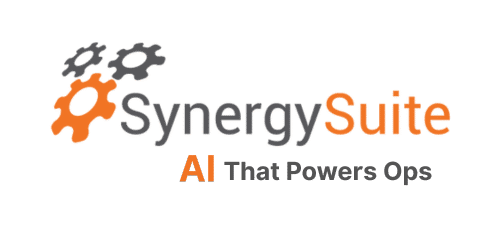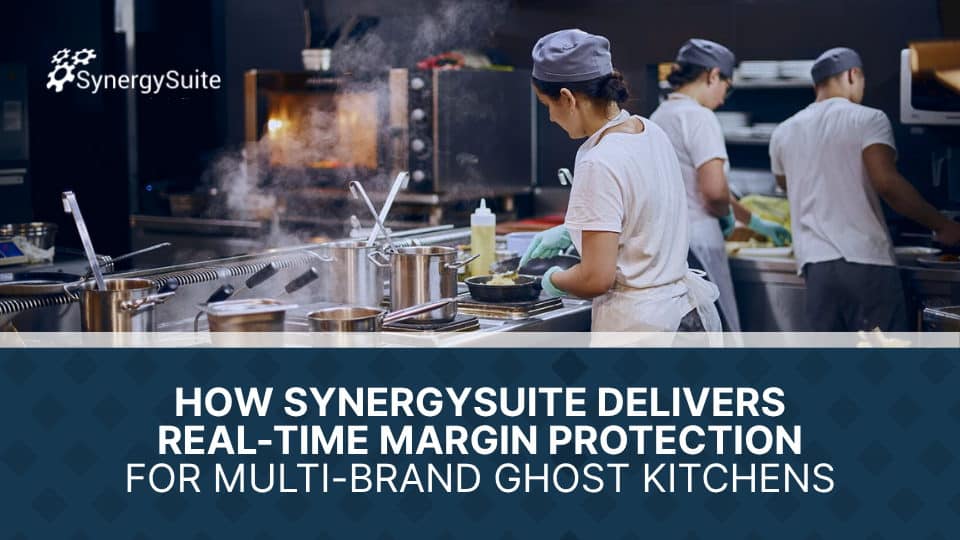The ghost kitchen sector continues its impressive growth trajectory, with the market projected to reach $196.69 billion by 2032. Yet despite this expansion, many delivery-only brands struggle with razor-thin margins that threaten their long-term viability.
On paper, virtual restaurants should outperform traditional brick-and-mortar operations. Lower overhead costs, streamlined staffing models, and no front-of-house expenses create an attractive unit economics story. However, the reality for many ghost kitchen operators tells a different story. Without proper back-of-house technology infrastructure, these delivery-only concepts find themselves burning through cash while managing operations through disconnected spreadsheets, multiple vendor portals, and manual workarounds. SynergySuite eliminates this fragmentation with a single source of truth, a foundation critical for brands planning to scale.
For virtual brands planning to grow from 3 locations to 30 or beyond, the foundation must include technology that delivers real-time operational control, recipe-level cost visibility, and automated systems that protect your profit margins before problems compound. Here’s your comprehensive blueprint for building sustainable ghost kitchen operations.
Understanding the Operational Complexity of Virtual Restaurants
Ghost kitchens face unique operational challenges that traditional restaurants rarely encounter. These delivery-only facilities often run multiple virtual brands from a single kitchen space, creating complexity that requires sophisticated management systems.
Common operational blind spots include:
- Inventory management across multiple concepts sharing the same physical storage space, making it difficult to track which ingredients belong to which brand and leading to cross-contamination of costs.
- Demand fluctuation and spoilage in commissary environments where production volumes can vary dramatically based on delivery platform promotions, weather patterns, and day-of-week trends.
- System fragmentation between prep kitchens, satellite ghost kitchen locations, and third-party delivery platforms that each operate on different technology stacks with no unified data flow.
- Lack of recipe-level visibility per virtual brand or sales channel, making it nearly impossible to understand true profitability at the menu item level.
The consequence of these operational gaps is a fragmented technology environment with no single source of truth for food cost performance, production requirements, or brand-level financial metrics. When operators can’t see problems in real-time, they can’t fix them before they damage the bottom line.
Transferable Success: Real-Time Operational Principles for Virtual Brands
While Costa Vida operates traditional restaurant locations rather than ghost kitchens, their operational transformation demonstrates principles that apply directly to multi-brand, delivery-only management.
When Costa Vida implemented SynergySuite across their multi-unit operation, they gained immediate access to real-time inventory tracking, recipe-level cost analysis, and daily profit and loss statements for every location. Restaurant managers could instantly identify cost variances, address portion control issues, and align labor scheduling with actual sales patterns rather than historical averages.
“SynergySuite has changed the way we think about issues. Previously, I didn’t have the same level of detail. Now when we have a question, I can look at the numbers first,” explained Kip Prestwich, VP of Innovation and Menu at Costa Vida.
This same real-time operational intelligence becomes even more critical in ghost kitchen environments where the multi-unit challenge is compounded by the multi-brand complexity. Speed of service, consistency across virtual brands, and tight cost control directly determine whether a concept can scale profitably or must shut down operations.
Essential Back-of-House Technology Stack for Ghost Kitchens
Building a profitable delivery-only brand or commissary operation requires specific technology capabilities that work together as an integrated system. Here’s what your BOH infrastructure must include to support sustainable growth.
1. Unified Inventory Control: Multi-Brand & Recipe-Level Costing
Ghost kitchens frequently operate multiple branded concepts under one roof, and without recipe-level inventory tracking, you’ll consistently overspend on ingredients while struggling to forecast demand accurately. Your inventory management solution should:
- Integrate seamlessly with your POS system and all delivery platform APIs to capture every transaction in real-time without manual data entry.
- Track inventory depletion by concept as orders flow through the kitchen, automatically calculating theoretical usage based on standardized recipes for each virtual brand.
- Reconcile theoretical versus actual usage to identify variances that signal portion control problems, theft, waste, or recipe accuracy issues that erode margins.
- Support multi-location visibility so commissary operators can see inventory levels, transfer requests, and production schedules across all satellite kitchens from a single dashboard.
2. Scalable Commissary Production & Automated Transfer Management
Central production facilities require specialized functionality that goes beyond standard restaurant inventory systems. Your platform must handle:
- Centralized batch cooking with recipe scaling that adjusts ingredient quantities based on production volumes while maintaining cost accuracy.
- Transfer order management between prep kitchens and satellite ghost kitchen locations, automatically depleting sending inventory and updating receiving inventory with proper cost allocation.
- Smart ordering algorithms that analyze sales velocity, lead times, and par levels to prevent both stockouts and overstocking situations that tie up working capital.
- Production scheduling tools that help commissary managers plan prep lists, allocate labor efficiently, and coordinate deliveries to multiple locations.
3. Proactive Margin Guardrails & AI-Driven Variance Alerts
Ghost kitchen margins remain under pressure, making proactive cost management essential for survival. Your software must automatically flag:
- Supplier price increases as soon as invoices are received, allowing operators to renegotiate pricing, find alternative suppliers, or adjust menu prices before margins compress.
- Recipe-level overuse by comparing theoretical ingredient consumption against actual usage patterns to identify portion control problems or waste issues specific to individual menu items.
- Underperforming menu items that generate insufficient contribution margin to justify their complexity, ingredient costs, or kitchen labor requirements.
Proactive automated alerts protect profitability by catching problems at the transaction level rather than waiting for month-end financial statements to reveal that damage has already occurred.
4. Mobile-Optimized Operations: Speed, Simplicity, Security
Ghost kitchens operate in fast-paced, space-constrained environments where desktop computers create workflow bottlenecks. Your technology platform should be:
- Fully functional on mobile devices so kitchen managers can conduct inventory counts, receive deliveries, and review performance metrics without leaving the line.
- Configured with role-based permissions that give prep cooks, operations managers, and finance teams exactly the data access and functionality they need without overwhelming users with irrelevant information.
- Optimized for speed because ghost kitchen staff don’t have time for complex workflows or systems that require extensive training to perform basic tasks.
Transforming Ghost Kitchen Operations from Reactive to Proactive
The fastest-scaling brands in the delivery-first restaurant sector aren’t making operational decisions based on intuition or outdated reports. They’re using real-time data to guide every aspect of their business.
With SynergySuite’s comprehensive restaurant management platform, virtual brand operators can:
- Build a centralized recipe library that standardizes ingredient specifications, preparation methods, and portion sizes across all virtual concepts and locations, ensuring consistency and accurate costing.
- Monitor margins by dish, by brand, and by location to understand which menu items drive profitability, which concepts perform best in different markets, and where operational improvements will have the greatest financial impact.
- Equip frontline operators with mobile tools that simplify inventory management, streamline labor scheduling, and digitize food safety compliance so managers spend less time on paperwork and more time improving operations.
- Eliminate end-of-month financial surprises by accessing daily profit and loss visibility that shows exactly where the business stands financially at any point during the accounting period.
“I’ve had managers say, ‘I have everything I need in the palm of my hand.’ And by saving managers time, we get better data, so win-win,” noted Prestwich about the operational transformation.
Taking the Next Step: Building a Scalable Ghost Kitchen Operation
The ghost kitchen industry continues evolving rapidly, and operators who invest in proper technology infrastructure position themselves for sustainable growth as the market expands.
If your virtual brand is poised for expansion, you cannot afford to wait for month-end reports to reveal preventable losses. SynergySuite is the unified control center that delivers the real-time, recipe-level data necessary to scale profitably from 3 locations to 30 and beyond.
Ready to Scale? Get Real-Time Control of Your Ghost Kitchen Margins.
Stop guessing and start growing with technology that gives you complete visibility and control over your virtual restaurant operations. SynergySuite’s cloud-based restaurant management platform helps ghost kitchen operators reduce food costs, eliminate waste, and scale profitably across multiple locations and virtual brands.





